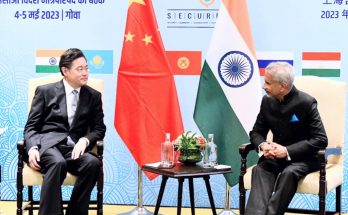 The sheer ambition and scale of the China-Pakistan Economic Corridor, which was unveiled during Chinese President Xi Jinping’s trip to Islamabad, is truly staggering. China’s unprecedented investment commitment to the tune of $46bn gives some substance to the hyperbolic expression “higher than the Himalayas, deeper than the Indian Ocean and sweeter than honey,” that has come to define bilateral relations between China and Pakistan for many decades.
The sheer ambition and scale of the China-Pakistan Economic Corridor, which was unveiled during Chinese President Xi Jinping’s trip to Islamabad, is truly staggering. China’s unprecedented investment commitment to the tune of $46bn gives some substance to the hyperbolic expression “higher than the Himalayas, deeper than the Indian Ocean and sweeter than honey,” that has come to define bilateral relations between China and Pakistan for many decades.
Sans Economics
President Xi’s visit, although touted as a visit with economics as its core objective, had an obvious strategic dimension; one that involves defence trade. Besides the promise of supplying Pakistan with eight submarines, it has emerged that China will provide 110 latest JF-17 Thunder fighter jets to Pakistan as the two countries forge closer defence cooperation. Also built on a transfer-of-technology basis, the JF-17 can be read as Pakistan’s response to India’s Rafale deal, coming on the heels of the latter. Shrouded between 51 agreements to boost economic cooperation during Xi’s trip, there are clear strategic undertones, belying the notion that the visit was not just about pure economics.
China-Pakistan Economic Corridor
The visit and, more so, the nature of bilateral agreements between China and Pakistan have undoubtedly ruffled some feathers in the Indian strategic circles.An investment worth $28bn in new trade and investment deals is part of the mega $46bn that will be used to construct the China Pakistan Economic Corridor (CPEC) project. The CPEC project will see the 3,000km trade route built over the next 15 years, with Chinese investments and companies building new roads and pipelines along the proposed route, which runs the length of Pakistan. Once complete (2030), it will give China the much coveted easy access to the Arabian Sea, Europe and even North Africa. The CPEC is likely to be the geostrategic conduit linking Kashgar in Xinjiang to Gwadar in Southern Pakistan. This corridor is part of the ‘belt’ that China is focussing on, in its “One Belt, One Road” initiative. The ‘belt,’ once complete, will tighten Beijing’s grip on the geopolitics of trade in South Asia, as China will try to connect its access to the Arabian Sea with its ‘road’ (its access to the Indian Ocean through its much hyped Marine Silk Road project).
Positives
The CPEC is likely to pull parts of Pakistan out of energy problems and is also expected to offer some job opportunities as it envisions Chinese investment in road, rail, electricity and other projects. For China, there are at least three positives once the CPEC is completed; it will provide China access to the Arabian Sea/Indian Ocean, Africa and Europe, transportation of goods and petroleum through the Gwadar deep sea port and subsequently through the super-highway to China will substantially cut down the amount of time that it currently takes to import oil and goods through the circuitous route up to Shanghai, and it will impart China the much sought regional heavy-weight status by encircling another heavy-weight of the region, India, completely. Unlike the ‘String of Pearls’ strategy which only has geostrategic nodal Chinese presence around India, the ‘belt and road’ creates the possibility of an encirclement strategy pivoted around India.
Negatives
The completion of the CPEC is likely to stoke Chinese ambitions of increasing maritime footprints in the Indian Ocean. A robust and increasingly assertive Chinese navy (PLAN) will only fuel such ambitions. The Xinjiang province bordering Pakistan is the most restive, turbulent and insurgent region in China. Along with an access point for goods of value, the CPEC has a high degree of possibility of becoming a thriving ground for trans-national terrorism. The anti-state sentiment in Xinjiang will only exacerbate the likelihood for militant ideologies to connect across the CPEC, throwing a spanner in regional security and stability of South Asia. This could become one of the greatest security challenges for India too.
Zero-Sum Game?
Couched in India’s backyard, for all its noble intentions, the CPEC will be a festering concern for India. Free continental connectivity between Islamabad and Beijing through the disputed territory is already a sovereignty issue for India. A circuitous Chinese presence around India through its ‘belt and road’ strategy, of which the CPEC is an integral part, will set in another great game between India and China. After India’s efforts for a ‘zone of peace’ and ‘denuclearisation’ of the Indian Ocean, the CPEC, in the long term, could well create a zero-sum game between Beijing and New Delhi: an unfortunate strategic contestation that could stunt growth in both the countries.
Author Profile
- India Writes Network (www.indiawrites.org) is an emerging think tank and a media-publishing company focused on international affairs & the India Story. Centre for Global India Insights is the research arm of India Writes Network. To subscribe to India and the World, write to editor@indiawrites.org. A venture of TGII Media Private Limited, a leading media, publishing and consultancy company, IWN has carved a niche for balanced and exhaustive reporting and analysis of international affairs. Eminent personalities, politicians, diplomats, authors, strategy gurus and news-makers have contributed to India Writes Network, as also “India and the World,” a magazine focused on global affairs.
Latest entries
 DiplomacyApril 23, 2024Resetting West Asia, re-booting the world, but not fast enough: T.S. Tirumurti
DiplomacyApril 23, 2024Resetting West Asia, re-booting the world, but not fast enough: T.S. Tirumurti India and the WorldApril 22, 2024India’s G20 Legacy: Mainstreaming Africa, Global South in global agenda
India and the WorldApril 22, 2024India’s G20 Legacy: Mainstreaming Africa, Global South in global agenda DiplomacyApril 10, 2024Diplomat-author Lakshmi Puri pitches for women power at LSR
DiplomacyApril 10, 2024Diplomat-author Lakshmi Puri pitches for women power at LSR India and the WorldApril 6, 2024UN envoy pitches to take India’s solutions to the world stage
India and the WorldApril 6, 2024UN envoy pitches to take India’s solutions to the world stage







